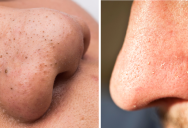All The Info You Need About The 6 Most Common Types Of Acne
There’s a myth out there that acne is a problem that arrives and departs with puberty. A lot of people know that’s not true, though, as skin problems can persist well into adulthood.
If you or someone you love struggles with controlling unsightly acne, here are the 6 most common types, as well as some advice on combating breakouts in the future.
6. Whiteheads

Image Credit: iStock
One of the most common forms of acne, whiteheads fall under the noninflammatory category.
These bumps have a white center surrounded by of a red halo, and you may even find a hair growing out of the middle.
Whiteheads are a direct result of clogged pores, which occur from dirt, oil sebum, or even dead skin cells that are closed within a pore.
A good, daily cleansing routine should help clear them up.
5. Blackheads

Image Credit: iStock
Like whiteheads, blackheads are also a noninflammatory type of acne. Instead of white centers, they are characterized by dark, black-colored spots that appear in the form of raised bumps.
Blackheads can also be caused by blocked pores and hair follicles. Cleansing is important here, too, as well as something like a pore strip like this one.
4. Pustules

Image Credit: iStock
More commonly referred to as pimples, pustules are often tender, larger bumps with a circular center.
Inside, you’ll find a yellow/white pus covering a red base – basically like whiteheads but much more inflamed.
Pustules can be caused by a number of factors, including an allergic reaction, insect bite, or clogged pores, so a consultation with a dermatologist is probably the best course of action.
3. Papules

Image Credit: iStock
Falling under the inflammatory category, papules are located under the surface of the skin.
They are raised, pink, and tender, and do not have a visible center.
Papules can be caused by several skin conditions, including warts, eczema, or skin infection. You can also get papules from an allergic reaction.
2. Nodules

Image Credit: iStock
Nodules are one of the most painful forms of acne.
These inflamed, hard lumps can be found deep within the skin and can become severely complicated.
Nodules are formed when clogged pores damage the cells and tissue deep beneath the skin’s surface.
Fixing them can be a painful process, so make sure and set yourself up with a good dermatologist before things go too far.
1. Cysts

Image Credit: iStock
Finally, the last form of acne is cysts, which are essentially pustules that become infected.
Cysts are often filled with pus and can cause severe skin issues such as scarring.
If acne has been an issue for you (or maybe a kiddo) knowledge is power. We hope this information helps you resolve your problem!

Sign up to get our BEST stories of the week straight to your inbox.




